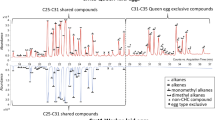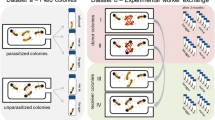Abstract
Insect cuticular hydrocarbons (CHCs) are primarily antidesiccation agents, but they also play crucial roles in intra- and interspecific communication, especially among social Hymenoptera. The complex CHC profiles of social insects have often been compared among individuals, kin, nestmates, colonies, and species. In the ant Formica exsecta, only the (Z)-9-alkene part of the CHC profile encodes the nestmate signal. Here, we showed that the other major part of the CHC profile with n-alkane components is influenced strongly by the task a worker performs (foraging vs nonforaging). This part of the profile is independent of the nestmate signal. Therefore, the CHC profile of F. exsecta workers is composed of two independent parts: a colony-specific (Z)-9-alkene profile under genetic influence and an environmentally influenced task-related n-alkane profile. The dissociating of the CHC profile into two or more independent parts has implications for the analysis and interpretation of past and future CHC studies.


Similar content being viewed by others
References
Akino, T. 2006. Cuticular hydrocarbons of Formica truncorum (Hymenoptera:Formicidae): description of new very long chained hydrocarbon components. Appl. Entomol. Zool. 41:667–677.
Akino, T., Yamamura, K., Wakamura, S., and Yamaoka, R. 2004. Direct behavioural evidence for hydrocarbons as nest mate recognition cues in Formica japonica (Hymenoptera: Formicidae). Appl. Entomol. Zool. 39:381–387.
Arnold, G., Quenet, B., Cornuet, J.-M., Masson, C., DeSchepper, B., Estoup, A., and Gasqui, P. 1996. Kin recognition in honeybees. Nature 379:498.
Ayasse, M., Marlovits, T., Tengö, J., Taghizadeh, T., and Francke, W. 1995. Are there pheromonal dominance signals in the bumblebee Bombus hypnorum L. (Hymenoptera: Apidae). Apidologie 26:163–180.
Ayasse, M., Birnbaum, J., Tengö, J., Doorn, A., Taghizadeh, T., and Francke, W. 1999. Caste and colony-specific chemical signals on eggs of the bumble bee, Bombus terrestrisL. (Hymenoptera: Apidae). Chemoecology 9:119–126.
Bagnères, A. G., and Morgan, E. D. 1991. The postpharyngeal glands and the cuticle of Formicidae contain the same characteristic hydrocarbons. Experientia 47:106–111.
Blomquist, G. J., and Dillwith, J. W. 1985. Cuticular lipids, pp. 117–154, in G. A. Kerkut, and L. I. Gilbert (eds.). Comprehensive Insect Physiology, Biochemistry and Pharmacology, vol 3. Pergamon, Oxford.
Boomsma, J. J., Nielsen, J., Sundström, L., Oldham, N. J., Tentschert, J., Petersen, H. C., and Morgan, E. M. 2003. Informational constraints on optimal sex allocation in ants. Proc. Natl. Acad. Sci. U. S. A. 100:8799–8804.
Châline, N., Sandoz, J. C., Martin, S. J., Ratnieks, F. L. W., and Jones, G. R. 2005. Learning and discrimination of individual cuticular hydrocarbons by honey bees (Apis mellifera). Chem. Senses 30:327–333.
Dani, F. R., Jones, G. R., Corsi, S., Beard, R., Pradella, D., and Turillazi, S. 2005. Nest mate recognition cues in the honey bee: Differential importance of cuticular n-alkanes and alkenes. Chem. Senses 30:1–13.
Dapporto, L. 2007. Cuticular lipid diversification in Lasiommata megera and Lasiommata paramegaera: the influence of species, sex, and population (Lepidoptera: Nymphalidae). Biol. J. Linn. Soc. 91:703–710.
D’Ettorre, P., and Heinze, J. 2005. Individual recognition in ant queens. Curr. Biol. 15:2170–2174.
Edney, G. W. 1977. Water Balance in Land Arthropods. Springer, New York, NY.
Gibbs, A. G., Crockett, E. L. 1998. The biology of lipids: integrative and comparative perspectives. Am. Zool. 38:265–267.
Gobin, B., Ito, F., and Billen, J. 2003. The subepithelial gland in ants: a novel exocrine gland closely associated with the cuticle. Acta Zoologica (Stockholm) 84:285–291.
Greene, M. J., and Gordon, D. M. 2003. Social insects—cuticular hydrocarbons inform task decisions. Nature 423:32.
Greene, M. J., and Gordon, D. M. 2007. Structural complexity of chemical recognition cues affects the perception of group membership in the ants Linephithema humile and Aphaenogaster cockerelli. J. Exp. Biol. 210:897–905.
Heinze, J., Stengl, B., and Sledge, M. F. 2002. Worker rank, reproductive status and cuticular hydrocarbon signature in the ant, Pachycondyla cf. inverse. Behav. Ecol. Sociobiol. 52:59–65.
Holldöbler, B., and Wilson, E. O. 1990. The Ants. Belknap, Cambridge, MA.
Howard, R. W., and Blomquist, G. J. 2005. Ecological, behavioral, and biochemical aspects of insect hydrocarbons. Annu. Rev. Entomol. 50:371–393.
Jackson, D., Martin, S. J., Ratnieks, F. L. W., and Holcombe, M. 2007. Spatial and temporal variation in pheromone composition of ant foraging trails. Behav. Ecol. 18:444–450.
Kaib, M., Franke, S., Francke, W., and Brandl, R. 2002. Cuticular hydrocarbons in a termite: phenotypes and a neighbour–stranger effect. Physiol. Entomol. 27:189–198.
Liebig, J., Peeters, C., Oldhan, N. J., Markstädter, C., and Hölldobler, B. 2000. Are variations in cuticular hydrocarbons of queens and workers a reliable signal of fertility in the ant Harpegnathos saltator? Proc. Natl. Acad. Sci. U. S. A. 97:4124–4131.
Liu, Z. B., Bagnères, A. G., Yamane, S., Wang, Q. C., and Kojima, J. 2001. Intra-colony, inter-colony and seasonal variations of cuticular hydrocarbon profiles in Formica japonica (Hymenoptera, Formicidae). Ins. Soc. 48:342–346.
Lockey, K. H. 1988. Lipids of the insect cuticle: Origin, composition and function. Comp. Biochem. Physiol. 89B:595–645.
Lockey, K. H., and Metcalfe, N. B. 1988. Cuticular hydrocarbons of adult Himatismus species and a comparison with 21 other species of adult Tenebrionid beetle using multivariate analysis. Comp. Biochem. Physiol. 91B:371–382.
Martin, S. J., and Drijfhout, F. P. 2009. How reliable is the analysis of complex cuticular hydrocarbon profiles by multivariate statistical methods? J. Chem. Ecol. doi:10.1007/s10886-009-9610-z.
Martin, S. J., Vitikainen, E., Helanterä, H., and Drijfhout, F. P. 2008a. Chemical basis of nestmate recognition in the ant Formica exsecta. Proc. R. Soc. B. 275:1271–1278.
Martin, S. J., Helanterä, H., and Drijfhout, F. P. 2008b. Colony-specific hydrocarbons identify nest mates in two species of Formica ant. J. Chem. Ecol. doi:10.1007/s10886-008-9482-7.
Martin, S. J., Helanterä, H., and Drijfhout, F. P. 2008c. Evolution of Species-Specific Cuticular Hydrocarbon Patterns in Formica Ants. Biol. J. Linn. Soc. 95:131–140.
Martin, S. J., Weihao, Z., and Drijfhout, F. P. 2009. Long-term stability of species-specific cuticular hydrocarbon profiles in hornets. Biol. J. Linn. Soc. (in press).
Monnin, T., Ratnieks, F. L. W., Jones, G. R., and Beard, R. 2002. Pretender punishment induced by chemical signalling in a queenless ant. Nature 419:61–65.
Neems, R. M., and Butlin, R. K. 1995. Divergence in cuticular hydrocarbons between parapatric subspecies of the meadow grasshopper, Chorthippus parallelus (Orthoptera, Acrididae). Biol. J. Linn. Soc. 54:139–149.
Nielsen, J., Boomsma, J. J., Oldham, N. J., Petersen, H. C., and Morgan, E. D. 1999. Colony-level and season-specific variation in the cuticular hydrocarbon profiles of individual workers in the ant Formica truncorum. Ins. Soc. 58:58–65.
Seeley, T. D. 1995. The Wisdom of the Hive. Harvard University Press, Cambridge.
Soroker, V., Hefetz, A., Cojocaro, M., Billen, J., Franke, S., and Francke, W. 1995. Structural and chemical ontogeny of the postpharyngeal gland in the desert ant Cataglyphis niger. Physiol. Entomol. 20:323–329.
Tentschert, J., Bestmann, H. J., and Heinze, J. 2002. Cuticular compounds of workers and queens in two Leptothorax ant species—a comparison of results obtained by solvent extraction, solid sampling, and SPME. Chemoecology 12:15–21.
Wagner, D., Brown, M. J. F., Broun, P., Cuevas, W., Moses, L. E., Chao, D. L., and Gordon, D. M. 1998. Task-related differences in the cuticular hydrocarbon composition of harvester ants, Pogonomyrmex barbatus. J. Chem. Ecol. 24:2021–2037.
Wagner, D., Tissot, M., Cuevas, W., and Gordon, D. M. 2000. Harvester ants utilize cuticular hydrocarbons in nestmate recognition. J. Chem. Ecol. 26:2245–2257.
Wagner, D., Tissot, M., and Gordon, D. M. 2001. Task-related environment alters the cuticular hydrocarbon composition of harvester ants. J. Chem. Ecol. 27:1805–1819.
Yamaoka, R. 1990. Chemical approach to understanding interactions among organisms. Physiol. Ecol. Jap. 27:31–52.
Acknowledgements
Many thanks go to Liselotte Sundström of Helsinki University for providing laboratory facilities in Finland and Duncan Jackson and Roger Butlin of Sheffield University for detailed comments. Funding was provided by NERC (NE/C512310/1 and NE/F018355/1) and to L. Sundström from Academy of Finland grants (206505).
Author information
Authors and Affiliations
Corresponding author
Rights and permissions
About this article
Cite this article
Martin, S.J., Drijfhout, F.P. Nestmate and Task Cues are Influenced and Encoded Differently within Ant Cuticular Hydrocarbon Profiles. J Chem Ecol 35, 368–374 (2009). https://doi.org/10.1007/s10886-009-9612-x
Received:
Revised:
Accepted:
Published:
Issue Date:
DOI: https://doi.org/10.1007/s10886-009-9612-x




